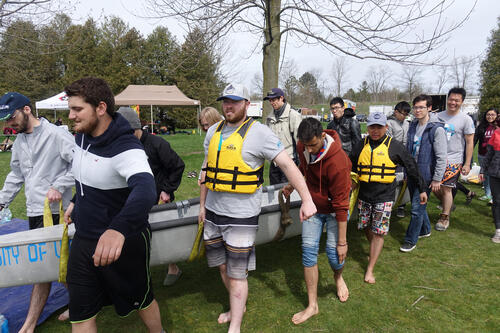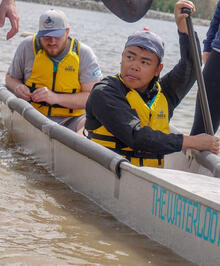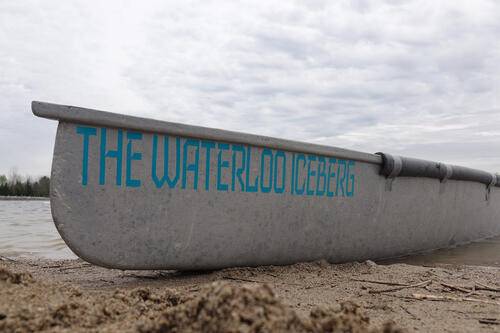
Engineering students paddle Laurel Creek in concrete canoes
National competition sees students taking on each other… and gravity.

National competition sees students taking on each other… and gravity.
By Devon Bradwell University RelationsOn Saturday, May 10, more than 260 engineering students from 16 Canadian universities gathered on the shores of the Laurel Creek Conservation Area. The purpose? To achieve what most would deem impossible—racing a fully buoyant concrete canoe.
The 24th Canadian National Concrete Canoe Competition (CNCCC) is an annual gathering that aims to put engineering prowess to the test. Every year, teams are given one simple, yet difficult task: shape the dense material that is concrete, into a fully functional canoe ready for on-water racing. The task involves year-long planning, requiring all members of a university’s team to bring their A-game.

Zining Wang, design lead for the Waterloo Iceberg team, explained that the process usually begins with experimentation, sourcing material that ideally would blend perfectly to make concrete float. Once that’s chosen, teams move on to the design phase, where canoes are created from scratch. (This is an engineering competition, after all.)
“The concrete canoe competition is an incredible opportunity for engineers to put what they’ve learned in class to the test in a situation unlike anything else,” said Sehrish Ahmad, a Waterloo civil engineering student who was co-president of the CNCCC’s event organizing committee. “There’s only so much you can learn from class before you want to just put it to the test all at once.”

Race day showcased high energy and good sportsmanship among competitors, offering participants a chance to exchange stories on their canoe-building experiences. While competition is fierce, the day is meant to be fun, allowing engineering students the chance to exercise their practical knowledge while uniting with other students similar to themselves.
“This event allows teams from coast-to-coast to interact and learn from each other and basically just have fun, it’s incredible,” said Joseph Geronimo, co-captain of the Waterloo Iceberg.
By the time the (concrete) dust had settled, the University of Waterloo placed eighth, with École de Technologie Supérieur taking home first prize.


Read more
Applying a broad range of tech skills and innovations, Waterloo’s students and alumni are adding value to Shopify’s merchants

Read more
Server is open to all University of Waterloo students working on startup ideas

Read more
Waterloo Engineering grad from the School of Architecture turns talent for drawing into a flourishing academic career
The University of Waterloo acknowledges that much of our work takes place on the traditional territory of the Neutral, Anishinaabeg, and Haudenosaunee peoples. Our main campus is situated on the Haldimand Tract, the land granted to the Six Nations that includes six miles on each side of the Grand River. Our active work toward reconciliation takes place across our campuses through research, learning, teaching, and community building, and is co-ordinated within the Office of Indigenous Relations.